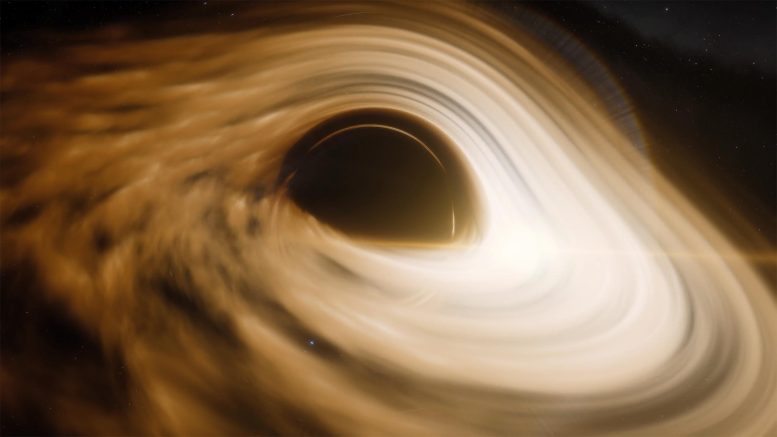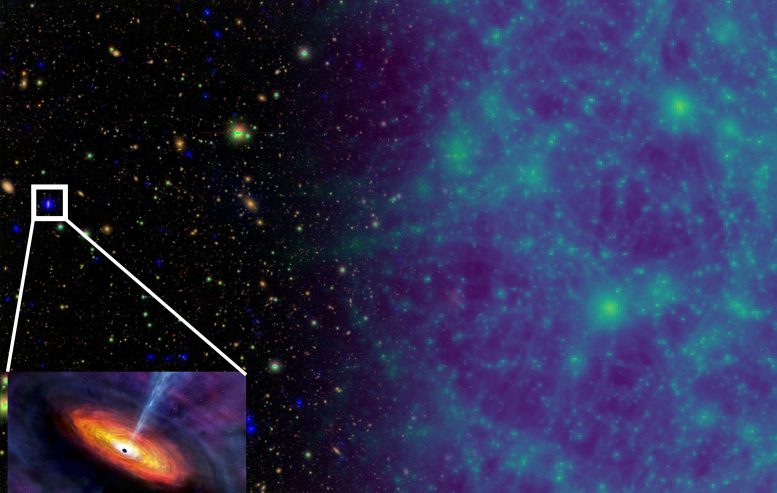
Researchers combined X-ray surveys and supercomputer simulations to track 12 billion years of cosmic black-hole growth.
Their findings reveal that black hole growth is primarily driven by accretion, with mergers playing a secondary role, especially in the early universe. These insights help explain the rapid growth of black holes during the universe’s younger phases.
How Do Supermassive Black Holes Get Super Massive?
By combining forefront X-ray observations with state-of-the-art supercomputer simulations of the buildup of galaxies over cosmic history, researchers have provided the best modeling to date of the growth of the supermassive black holes found in the centers of galaxies. Using this hybrid approach, a research team led by Penn State astronomers derived a complete picture of black-hole growth over 12 billion years, from the Universe’s infancy at around 1.8 billion years old to now at 13.8 billion years old.
The research comprises two papers, one published in The Astrophysical Journal in April 2024, and one as yet unpublished that will be submitted to the same journal. The results will be presented at the 244th meeting of the American Astronomical Society, held June 9 through June 13 at the Monona Terrace Convention Center in Madison, Wisconsin. The results were featured during a press conference that was live-streamed and is available to view now:
Mechanisms of Supermassive Black Hole Growth
“Supermassive black holes in galaxy centers have millions-to-billions of times the mass of the Sun,” said Fan Zou, a graduate student at Penn State and first author of the papers. “How do they become such monsters? This is a question that astronomers have been studying for decades, but it has been difficult to track all the ways black holes can grow reliably.”
Supermassive black holes grow through a combination of two main channels. They consume cold gas from their host galaxy — a process called accretion — and they can merge with other supermassive black holes when galaxies collide.
Data Sources and Accretion Measurement
“During the process of consuming gas from their hosting galaxies, black holes radiate strong X-rays, and this is the key to tracking their growth by accretion,” said W. Niel Brandt, Eberly Family Chair Professor of Astronomy and Astrophysics and professor of physics at Penn State and a leader of the research team. “We measured the accretion-driven growth using X-ray sky survey data accumulated over more than 20 years from three of the most powerful X-ray facilities ever launched into space.”
The research team used complementary data from NASA’s Chandra X-ray Observatory, the European Space Agency’s X-ray Multi-Mirror Mission-Newton (XMM-Newton), and the Max Planck Institute for Extraterrestrial Physics’ eROSITA telescope. In total, they measured the accretion-driven growth in a sample of 1.3 million galaxies that contained over 8,000 rapidly growing black holes.

“All of the galaxies and black holes in our sample are very well characterized at multiple wavelengths, with superb measurements in the infrared, optical, ultraviolet, and X-ray bands,” Zou said. “This allows for robust conclusions, and the data show that, at all cosmic epochs, more massive galaxies grew their black holes by accretion faster. With the quality of the data, we were able to quantify this important phenomenon much better than in past works.”
Mergers and Simulated Growth
The second way that supermassive black holes grow is through mergers, where two supermassive black holes collide and merge together to form a single, even more massive, black hole. To track growth by mergers, the team used IllustrisTNG, a set of supercomputer simulations that model galaxy formation, evolution, and merging from shortly after the Big Bang until the present.
“In our hybrid approach, we combine the observed growth by accretion with the simulated growth through mergers to reproduce the growth history of supermassive black holes,” Brandt said. “With this new approach, we believe we have produced the most realistic picture of the growth of supermassive black holes up to the present day.”
Impact and Historical Growth Patterns
The researchers found that, in most cases, accretion dominated black-hole growth. Mergers made notable secondary contributions, especially over the past 5 billion years of cosmic time for the most-massive black holes. Overall, supermassive black holes of all masses grew much more rapidly when the Universe was younger. Because of this, the total number of supermassive black holes was almost settled by 7 billion years ago, while earlier in the Universe many new ones kept emerging.
“With our approach, we can track how central black holes in the local universe most likely grew over cosmic time,” Zou said. “As an example, we considered the growth of the supermassive black hole in the center of our Milky Way Galaxy, which has a mass of 4 million solar masses. Our results indicate that our Galaxy’s black hole most likely grew relatively late in cosmic time.”
Reference: “Mapping the Growth of Supermassive Black Holes as a Function of Galaxy Stellar Mass and Redshift” by Fan Zou, Zhibo Yu, W. N. Brandt, Hyungsuk Tak, Guang Yang and Qingling Ni, 29 March 2024, The Astrophysical Journal.
DOI: 10.3847/1538-4357/ad27cc
In addition to Zou and Brandt, the research team includes Zhibo Yu, graduate student at Penn State; Hyungsuk Tak, assistant professor of statistics and of astronomy and astrophysics at Penn State; Elena Gallo at the University of Michigan; Bin Luo at Nanjing University in China; Qingling Ni at the Max Planck Institute for Extraterrestrial Physics in Germany; Yongquan Xue at the University of Science and Technology of China; and Guang Yang at the University of Groningen in the Netherlands.
Funding from the U.S. National Science Foundation, the Chandra X-ray Center, and Penn State supported this work. The work was also made possible by the sharing of the IllustrisTNG simulation results with the scientific community.
3 Comments
but it has been difficult to track all the ways black holes can grow reliably.”
do you mean “but it has been difficult to reliably track all the ways black holes can grow.”
1. The Universe is multidimensional. It is a Macrocosm structured, stratified on multiple dimensions and planes, with different frequencies and vibrations. (M-theory of theoretical physics, for example, talks about 11 such dimensions.)
2. The PHYSICAL Universe was born from the primordial supermassive black holes. I call this theory “The Supermassive Black Holes Bang”. (It’s a theory of mine with few elements borrowed from metaphysics.) Consequently, there’s no such thing as the Big Bang; or at least there’s no such thing as the Big Bang in the current format that is presented in the Standard Model. The Big Bang could be seen as a primordial supermassive black hole from where later many other such structures formed.
3. All the galaxies are born from the supermassive black holes found in their centers. The giant black holes regulate their entire structure and physiology (possibly via dark matter) ever since their beginnings, as dwarf galaxies. Dwarf galaxies represent basically the galaxies in their infancy, after their birth from their supermassive black holes. There were recently made multiple observations which showed again and again that the supermassive black holes release periodically superheated jets of energy, matter, gas all throughout their galactic environments, feeding their galactic hosts systematically. These observations include the supermassive black holes of Henize 2-10, NGC 1275, M27, SDSS J1531, or even Milky Way’s Sagittarius A. Many other cases of supermassive black holes in the early Universe, with their galactic hosts in their infancy having the same mass (1 to 1), prove again that the galaxies are born from their supermassive black holes, and after that they gradually evolve, expand.
4. Dark energy, which fills the physical Universe, comes out of the supermassive black holes as well. Scientists also theorized that recently, in 2023. This explains, for example, why some areas of the Universe expand faster than other areas. I believe that a larger concentration of supermassive black holes which release dark energy into one area of the Cosmos would lead inevitably at a faster expansion of space within that area.
5. The different types of energies released by the supermassive black holes during the galactic evolution (dark energy, dark matter, or baryonic matter, which, as we know, is energy condensed into this physical plane) shape the galaxies in a spiral or lenticular way. By the mode in which the supermassive black holes release these energies into this dimensional layer, the galaxies get that flat shape. In the case of the elliptical galaxies, I suspect that the supermassive black hole physics is changed; in other words, here they stopped releasing dark repulsive energy winds perpendicular to the galactic structure, and because of this reason these galaxies are not flat, disk-shaped.
6. All the energy that condenses and materializes into this four dimensional spacetime environment comes, via these supermassive black holes, from the higher dimensional layers of the Macrocosm. Therefore, the origins of the physical Universe are found, via these supermassive black holes, NOT in another parallel Universe (as some physicists like John Wheeler used to theorize in the past), but in the higher dimensional layers of the same Universe or Macrocosm. The black holes could be seen in this way as interdimensional gateways of energy exchange between this physical layer observed by us and the higher extradimensional planes of the Macrocosm.
Metaphysics also supports the idea that the physical plane is emanated from the higher macrocosmic layers. This emanation is done through the same black holes. More future scientific observations will clarify the validity of my statements revealed here very briefly.
What are the origins, the essence, and the nature of the entire multidimensional Macrocosm? It’s a very long, complicated story (too long for this comment section), a story around which I developed my own personal theory which tries to explain the ultimate nature of nature.
It has to be mentioned here that not all galaxies contain at their center a supermassive black hole, and I’m referring here especially to the dwarf, satellite galaxies, like the Magellanic Clouds. In their case, according to the Supermassive Black Holes Bangs model, they would be formed as independent small galactic structures, in general irregular, with the energy, gas ejected from the central supermassive black hole of the main galaxy around which they revolve. Some of the clouds of gas ejected from the supermassive black hole would escape the galactic environment and would organize themselves later, when new stars would be born, in the form irregular, dwarf, satellite galaxies, with no supermassive black holes at their center. Astronomers from the Green Bank Telescope observed recently that 250 neutral gaseous clouds were blasted out from the center of the Milky Way galaxy, being the product of the same phenomenon that produces the Fermi Bubbles. The clouds carry with them matter out of the galactic nucleus. The velocities of these hydrogen clouds are tremendous, making them to even escape the galaxy, and the main suspect for this phenomenon is none other than the activity of the inevitable central supermassive black hole, Sagittarius A and its exhaust vent. Therefore, the clouds that escape the galactic environment would lead at the formation and the evolution of the irregular, satellite galaxies. In this way, the supermassive black hole would feed not only its own galaxy with gas, but also the satellites that lack one at their centers. That’s how satellite galaxies, with no central supermassive black holes, would form and would evolve.